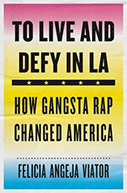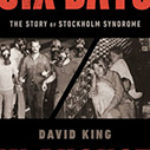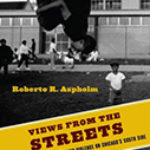To Live And Defy In La: How Gangsta Rap Changed America

Author: Felicia Angeja Viator
Publisher: Cambridge, MA: Harvard University Press, 2020. 352p.
Reviewer: Nicholas Stoia | May 2021
In 1984, the Los Angeles Police Department acquired two tank-like, six-ton armored personnel carriers that the US Army had used in the Vietnam War, and repurposed them for their fight against two connected and growing problems in the city: gangs and rock cocaine. The police were frustrated by their inability to break through the increasingly sophisticated security of “rock houses” before suspects inside could destroy evidence. So, they attached steel battering rams to the carriers, painted them blue, wrote “L.A.P.D. Rescue Vehicle” on the sides, and anticipated a new tactical edge in the war on drugs. On 6 February 1985, Chief Daryl Gates christened one of the rams with a bottle of Thunderbird wine and rode along as it rolled through the city streets and then smashed through the front wall of a suspected rock house. The gaping hole gave police quick and easy access, but inside they found only a small group of terrified citizens, including small children, sitting in the living room eating ice cream. Among the responses to this debacle were lawsuits, community outrage, and attempts to decommission the ram. Another was the song “Batterram,” in which Compton rapper Toddy Tee described the unstoppable power of the police, as embodied by the ram. The track quickly became a local sensation, because it resonated with so many young Black men in South Los Angeles who resented the LAPD for the militarized policing of their communities.
The story of “Batterram” is one of many in To Live and Defy in LA: How Gangsta Rap Changed America, in which Felicia Angeja Viator shows how LA rap was, from its beginning, an artistic response to police power. This persistent focus on the police distinguished the regional style from the New York rap that dominated the genre early on and earned it the label “gangsta rap.” As it became increasingly influential within hip-hop, its attributes infused the genre as a whole; and when rap came to dominate popular music, gangsta rap changed the culture nationwide.
The backdrop of To Live and Defy in LA is the acute plight in the cities of Southern California after the “tax revolt” of the late 1970s and early 1980s, and the slashing of public services. These shifts “coincided with, and resulted in, the further expansion of local street gangs, the rise of violent crime, and the spread of illicit industries, including guns and narcotics trafficking.” The police, along with judges, prosecutors, and others, conflated full-fledged gang members with the much larger number of young Black Angelinos who merely “‘affiliated’ or ‘associated’ themselves with local gang sets.” Most “managed generally to abide by the law,” but “accepted gang members in their communities as if they were the troublesome relatives in an extended family.” Eventually, this expanding view of gang membership “meant that all young black Angelinos, whether involved with local gangs or not, bore the racialized stigma of the gangster.” (They often had a reciprocal perception of the LAPD, whom they feared “as if it were just as ruthless as any street gang, and more sinister.”)
Mobile dance parties were essential to the emerging regional genre, but dependent on the participation of gang members: “The fact is that gun-toting gangbangers, and the thousands of young people who were peripherally affiliated with them, were integral to the core mobile dance demographic that so many young strivers depended on.” Early LA rappers like Toddy Tee and his partner Mixmaster Spade sold their homemade “street tapes” to the very entities that the police and community leaders despised, and locals loved the music because it “was a rare reflection of their lived reality.”
Although New York derided LA rap, it was the Queens group Run-DMC that galvanized the nascent West Coast scene. They had severed rap from disco and honored hip-hop’s breakdancing origins with “the sneakers, jeans, T-shirts, bomber jackets, and black hats” that were the “uniform of the inner city.” In 1986, on tour to prove the nationwide potential of hip-hop, pandemonium broke out at their Los Angeles concert. Following the “rap riot,” Run-DMC vacillated between defending hip-hop from moral crusaders and joining them, blaming the “gangbangers” who had “sabotaged” the show. (Viator astutely contextualizes rap among contemporaneous genres like punk and heavy metal that likewise stoked concerns about violence, noting that only rap led to debates centered on race that cast all fans as gangsters.) Modern gangsta rap emerged in the wake of the concert, which “presented a window of opportunity for LA’s own rap hopefuls, who recognized the value of the limelight, even when it was harsh.”
The creation and ascension of NWA is central to Viator’s account. She relates the early days in detail: the entrepreneurial Eric Wright (Eazy-E), a drug dealer seeking a way out, who launched the small label Ruthless Records in 1986; his poaching of Andre Young (Dr. Dre), the talented DJ and audio engineer, from Kru-Cut Records, where he was frustrated by lack of creative control and “tired of crafting electro-ballads and performing dance moves in medical scrubs.” She describes O’Shea Jackson (Ice Cube) cutting his teeth at a skating rink, where he delivered verses that were “totally street, totally dirty,” including obscene parodies—“My Penis,” for instance, to the tune of Run-DMC’s “My Adidas”—to the delight of Compton’s toughest audiences; and Dre’s subsequent recruitment of Ice Cube from Kru-Cut, where the latter felt restrained and unfulfilled, “unable to do what he did best: write authentic street tales about the homeboys from around the way.” At Ruthless, they were unrestrained, encouraged to be “as hardcore as you want to be.” The label was “rooted in the reality that those same toughs and gangsters” that Run-DMC had denounced “were LA’s most loyal rap fans,” and in “the counterintuitive belief that their stories were marketable.”
With the 1987 release of the single “The Boyz-N-The-Hood,” Ruthless set the new standard for LA rap. The lyrics “were plot-driven narratives, in contrast to the loosely constructed rap braggadocio that characterized most hip-hop records.” The song pursued the realism that had been growing in rap since the 1982 release of “The Message,” a disco-inspired track by Grandmaster Flash and the Furious Five; but it was also—like “Batteram”—highly localized, “written in the LA vernacular of drugs, classic cars, and police abuse.” The record combined the localized narratives descending from Toddy Tee and others with the modern, disco-free style of Run-DMC.
Early gangsta rap hinged on its resonance with those caught up in gang violence and the LAPD’s powerful new mandate for “hard-nosed measures.” After violence spilled over into the city’s posh neighborhoods, engendering a flood of media attention, the state passed laws including mandatory sentencing rules for felonies committed by people just marginally associated with gang organizations, and in LA Chief Gates—possibly the most central character in this book after Eazy-E et al.—announced “Operation Hammer,” which would round up juvenile delinquents in “gang sweeps,” and “‘make war’ on all the ‘rotten little cowards’ terrorizing the city.” It was in this climate that NWA released their groundbreaking Straight Outta Compton. They were responding in part to the growing attention to gang violence in popular culture, exemplified by the 1988 Dennis Hopper film Colors, but they told the story from the receiving end of “Operation Hammer,” rather than from the perspective of the film’s two white LAPD officers. As Ice Cube put it, “We’re trying to show how it is on the other side, what it’s like to have to deal with that kind of asshole cop on a day-to-day basis.” They represented themselves as “underground street reporters” and claimed a kind of authenticity missing from both Colors and New York rap.
Viator scrutinizes the emergence of MTV, its early exclusion of many Black artists, and its eventual reliance on them in order to remain relevant. Their show Yo! MTV Raps was instrumental in gaining broader exposure for hip-hop and capturing a wider national audience, especially the white teenage boys who would become such devoted fans. Unlike most established rockers (but like their new wave contemporaries) hip-hop artists immediately recognized the opportunities music videos offered for cultivating their personas. NWA’s first music video, “Straight Outta Compton,” depicted a gang sweep from the target’s point of view. Despite the bluster and braggadocio of the song, the video casts it as “an expression of powerlessness. Only the police wield actual deadly weapons, and they use them, zealously, to round up NWA and their friends.” But MTV rejected the video because it “glorified violence.” “The cable outlet that had always seemed willing to rile censors with rock videos now proved uncomfortable with a dramatization of the sort of police harassment considered routine in black Los Angeles.” NWA was, naturally, deeply resentful. For Ice Cube, the only “problem” with the video was that it told the truth and forced viewers to reckon with injustice. But, perhaps predictably, the network’s refusal led to a boost for competing channels that agreed to play the video and generated a cascade of sales and publicity for the group. The whole affair ultimately played into NWA’s marketing strategy, in which controversy was currency.
NWA’s most inflammatory song was “Fuck Tha Police.” Law enforcement was not a fan of the track, and the Fraternal Order of Police advised members not to provide security during the group’s 1989 national tour, in an effort to shut down shows. Even the FBI chimed in, scolding the group’s label and pontificating on the role of music in society. But NWA used the criticism as a “springboard for more exposure and public sympathy.” (The FOP and FBI apparently failed to anticipate this brilliant counterstroke.) Both the album and the song had a huge influence outside of LA. New York rapper Jay-Z found more in the album than just the “nod in his direction” that he got from prominent New York groups; “he heard his own voice.” In Philadelphia, the sixteen-year-old ?uestlove was “thunderstruck” after a friend showed him “Fuck tha Police”: “There were certain things that artists didn’t do…You just didn’t say, ‘Fuck the police.’” He ditched chamber orchestra so that he could listen to rest of the album. NWA helped make 1988 the watershed year when hip-hop broke out of its New York mold and the California “gangster” archetype took hold within the genre.
Viator doesn’t gloss over NWA’s faults: she notes the battery charges against Dr. Dre for an assault on Denise “Dee” Barnes; his and Eazy-E’s tasteless jokes about the brutal police beating of Rodney King; the publication of “luridly misogynistic” tracks like “To Kill a Hooker,” “Findum, Fuckum, & Flee,” and “One Less Bitch”; and she includes incisive criticisms from various perspectives. Some in the industry “argued that LA rappers had abused their public platform by promoting an apolitical version of black militancy, even violent anarchy.” A critic told the Los Angeles Times that NWA made “black exploitation records,” while another at the Sentinel, the long-established African American-owned newspaper, called them “the ultimate sell-outs.” LA activist Leon Watkins worried that NWA and Ice Cube were “normalizing gang violence and urban plight” and exploiting a “volatile situation.”
The book ends with the 1992 Los Angeles uprisings in response to the Rodney King verdict, which appeared to confirm gangsta rap as an “honest response to a real American crisis.” Multiple rappers, including Ice-T and Tupac Shakur, argued that they had been warning about the explosive conditions for years. “Anything you want to know about the riots,” observed Ice Cube, “was in the records before the riots.”
To Live and Defy chronicles the emergence of gangsta rap and its transformation of hip-hop and popular culture. As Viator notes in her closing paragraph, “The lasting legacy of Los Angeles gangsta rap is not a hip-hop genre ‘co-opted by the mainstream’ but rather a twenty-first century pop culture landscape co-opted by hip-hop.” But the book is also a thorough and timely study of an important intersection between music and social conditions, because the ascendance of gangsta rap since the 1980s reflects the rise of militarized policing over that same span, and we’ve seen all too clearly in recent years why it continues to resonate.
Nicholas Stoia is Assistant Professor of Music at Duke University


